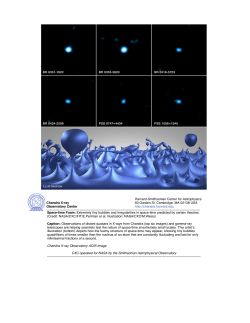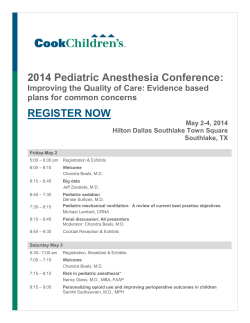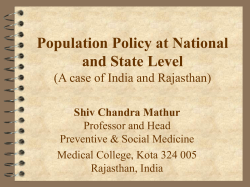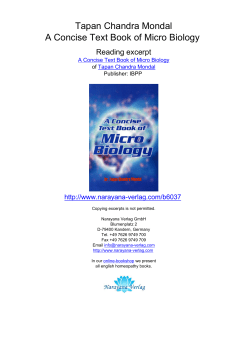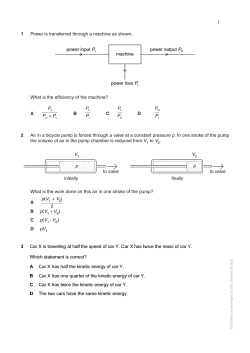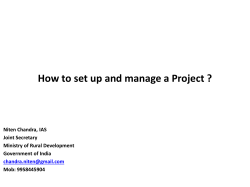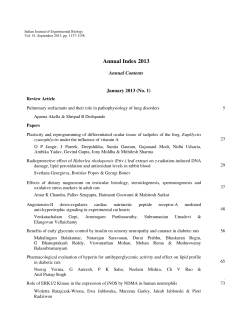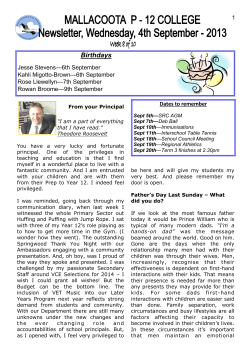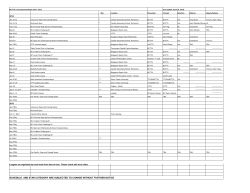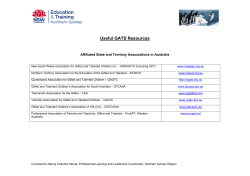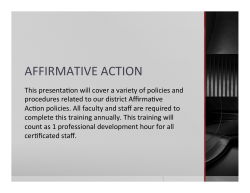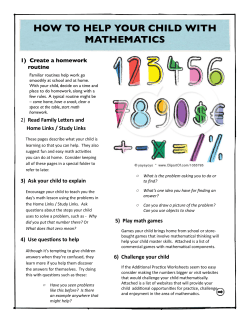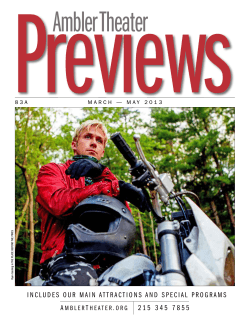
Document 212307
How to Write an ICSE SEIP Paper? Sa3sh Chandra ICSE 2014 Preparatory Event Computer Associates, Inc., Hyderabad April 2013 (These slide reflect my personal opinions and not necessarily the official posi3on of ACM or of my employer.) Copyright © 2013 Sa3sh Chandra What is ICSE SEIP? • SoOware Engineering in Prac(ce – Industry track of ICSE • [From CFP] SEIP seeks papers that highlight industrial challenges, breakthroughs, and case studies. SEIP especially seeks papers – with high take-‐away value to help prac33oners improve their own soOware engineering processes, techniques, and results. – also valuable are papers that help academics iden3fy important new areas of research. • [From CFP, italiciza3on mine] Submissions will be evaluated on the basis of prac(cality to industry, originality, significance of contribu3on, applicability, quality of presenta3on, and discussion to related work Copyright © 2013 Sa3sh Chandra ICSE Main vs. ICSE SEIP • Commonali3es – Originality of content (not published elsewhere) – Academic style in presenta3on – Peer reviewing: determina3on of acceptance or rejec3on is done by people in the research community • Unique to SEIP – Relevance to industry is very important • Not a poor man’s main track! – Case studies and experience reports are just as welcome as new technical approaches – Broader than academic topics Copyright © 2013 Sa3sh Chandra What is appropriate for SEIP? A lot! List of 2013 ICSE SEIP accepted papers at 2013.icse-conferences.org Detec%ng Inconsistencies in Wrappers: A Case Study Henning Femmer, Dharmalingam Ganesan, Mikael Lindvall, and David McComas (TU Munich, Germany; Fraunhofer CESE, USA; NASA Goddard Space Flight Center, USA) Pathways to Technology Transfer and Adop%on: Achievements and Challenges (Mini-‐Tutorial) Dongmei Zhang and Tao Xie (MicrosoD Research, China; North Carolina State University, USA) Automa%c Detec%on of Performance Devia%ons in the Load Tes%ng of Large Scale Systems Haroon Malik, Hadi Hemma3, and Ahmed E. Hassan (Queen's University, Canada; University of Waterloo, Canada) Efficient and Change-‐Resilient Test Automa%on: An Industrial Case Study Suresh Thummalapenta, Pranavadaga Devaki, Saurabh Sinha, Sa3sh Chandra, Sivagami Gnanasundaram, Deepa Nagaraj, and Sampathkumar Sathishkumar (IBM Research, India; IBM Research, USA; IBM, India) A Characteris%c Study on Failures of Produc%on Distributed Data-‐Parallel Programs Sihan Li, Tian Xiao, Hucheng Zhou, Haoxiang Lin, Haibo Lin, Wei Lin, and Tao Xie (North Carolina State University, USA; Tsinghua University, China; MicrosoD Research, China; MicrosoD, China; MicrosoD, USA) Categorizing Bugs with Social Networks: A Case Study on Four Open Source SoOware Communi%es Marcelo Serrano Zaneh, Ingo Scholtes, Claudio Juan Tessone, and Frank Schweitzer Copyright © 2013 Sa3sh Chandra (ETH Zurich, Switzerland) Predic%ng Bug-‐Fixing Time: An Empirical Study of Commercial SoOware Projects Predic%ng Bug-‐Fixing Time: An Empirical Study of Commercial SoOware Projects Hongyu Zhang, Liang Gong, and Steve Versteeg (Tsinghua University, China; CA Technologies, Australia) A Study of Enabling Factors for Rapid Fielding: Combined Prac%ces to Balance Speed and Stability Stephany Bellomo, Ipek Ozkaya, and Robert L. Nord (SEI, USA) Distributed Development Considered Harmful? Ekrem Kocaguneli, Thomas Zimmermann, Chris3an Bird, Nachiappan Nagappan, and Tim Menzies (West Virginia University, USA; MicrosoD Research, USA) MIDAS: A Design Quality Assessment Method for Industrial SoOware Ganesh Sg, Girish Suryanarayana, Tushar Sharma, and Shrinath Gupta (Siemens, India) Es%ma%ng SoOware-‐Intensive Projects in the Absence of Historical Data Aldo Dagnino (ABB Research, USA) Scaling Agile Methods to Regulated Environments: An Industry Case Study Brian Fitzgerald, Klaas-‐Jan Stol, Ryan O'Sullivan, and Donal O'Brien (Lero, Ireland; University of Limerick, Ireland; QUMAS, Ireland) Is Time-‐Zone Proximity an Advantage for SoOware Development? The Case of the Brazilian IT Industry Rafael Prikladnicki and Erran Carmel (PUCRS, Brazil; American University, USA) User Involvement in SoOware Evolu%on Prac%ce: A Case Study Dennis Pagano and Bernd Bruegge (TU Munich, Germany) Copyright © 2013 Sa3sh Chandra Evalua%ng Usefulness of SoOware Metrics: An Industrial Experience Report Eric Bouwers, Arie van Deursen, and Joost Visser (SoDware Improvement Group, Netherlands; TU DelD, Netherlands) Reducing Human Effort and Improving Quality in Peer Code Reviews using Automa%c Sta%c Analysis and Reviewer Recommenda%on Vipin Balachandran (VMware, India) Agility at Scale: Economic Governance, Measured Improvement, and Disciplined Delivery Walker Royce, Scog Ambler, and Alan Brown (IBM, USA; Ambler and Associates, Canada; University of Surrey, UK) Measuring Architecture Quality by Structure Plus History Analysis Robert Schwanke, Lu Xiao, and Yuanfang Cai (Siemens Research, USA; Drexel University, USA) Technical Debt: Past, Present, and Future (Panel) Steven Fraser (Cisco Systems, USA) Obtaining Ground-‐Truth SoOware Architectures Joshua Garcia, Ivo Krka, Chris Magmann, and Nenad Medvidovic (University of Southern California, USA; Jet Propulsion Laboratory, USA) JST: An Automa%c Test Genera%on Tool for Industrial Java Applica%ons with Strings Indradeep Ghosh, Nastaran Shafiei, Guodong Li, and Wei-‐Fan Chiang (Fujitsu Labs, USA; York University, Canada; University of Utah, USA) Copyright © 2013 Sa3sh Chandra Appropriate and the Not so … • • • • A new technical approach A case study A taxonomy Iden3fying challenges in a new area • Survey of exis3ng tools in some domain • (Unsubstan3ated) opinion Copyright © 2013 Sa3sh Chandra Academic Style of Presenta3on-‐I • • • • • • • Abstract (1 paragraph) Introduc3on (2-‐3 pages) Main sec3on (3-‐4 pages) Evalua3on and Discussion (2-‐3 pages) Related work (1-‐2 pages) Conclusion (1 paragraph) References Adhere to page limit and formahng … Copyright © 2013 Sa3sh Chandra How are SEIP papers judged? • Is it interes3ng to read? – Subjec3ve • Is it well-‐wrigen? – You are not wri3ng a patent applica3on! • Does the contribu3on seem substan3al? – Very subjec3ve • Does the evalua3on (if any) in the paper seem convincing? – Big difference from white papers • Is related work discussed reasonably comprehensively? Copyright © 2013 Sa3sh Chandra How to posi3on your work towards SEIP? • Interes3ng to read – The problem should be presented in a way that people outside your immediate sehng can relate to – Example • In our company, we needed to connect system X to system Y using technology Z. Here’s how we did it. • In enterprise sehngs, there is recurring need to connect systems from different vendors. Here we describe a general approach to inter-‐operability, and then describe our specific embodiment in the context of system X and system Y. – Give adequate background. Do not assume that your reviewer will know anything about X and Y. Copyright © 2013 Sa3sh Chandra How to posi3on your work towards SEIP? • Does the contribu3on seem substan3al? – It is important to highlight the contribu3on rela(ve to the closely related previous work – Example • We connected system X to system Y using a homegrown system, because we were not happy with technology Z • Compared to the popular off-‐the-‐shelf method of accomplishing this using Z, our technique achieves x% beger throughput on a set of important benchmarks Copyright © 2013 Sa3sh Chandra How to posi3on your work towards SEIP? • Is the evalua3on convincing? – Some data, as long as it is germane, is almost always beger than no data – Example • We implemented a new UI for this requirements management system and people like it! • We collected a survey of par3cipants in a study in which half of the par3cipants were asked to accomplish these tasks on the new UI … etc. Copyright © 2013 Sa3sh Chandra Academic Style of Presenta3on-‐II • The introduc3on is arguably the most important part of your submission • A reader must be able to get a gist of your en3re paper by reading the introduc3on – What problem did you set out to study? – Why is the problem important to anyone besides you? – Summary of what one will learn in this paper – What is your claim to fame? • This is the most comprehensive comparison ever of system A vs. B • This approach begers the state of the art in following ways. • We iden3ty issues that no one has ar3culated before in C. Copyright © 2013 Sa3sh Chandra
© Copyright 2025
